|
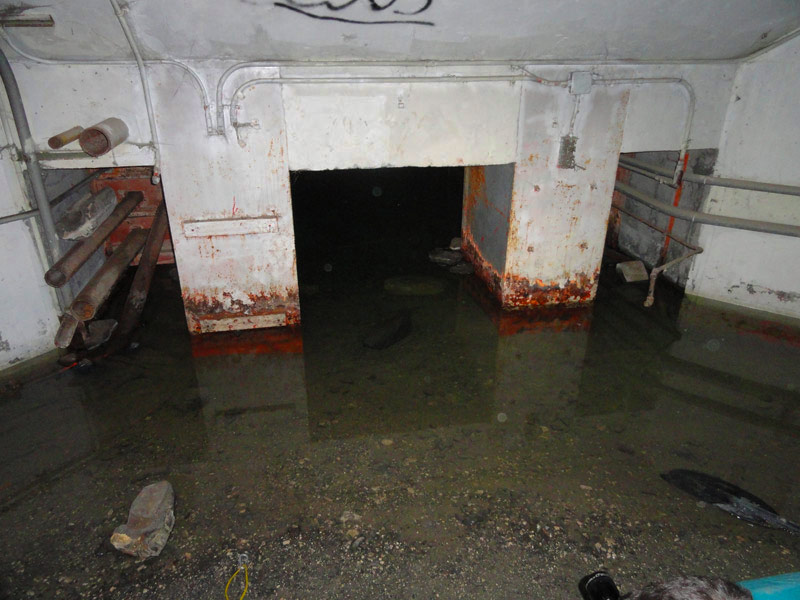
|
|
Half-buried
entrance to blast lock #2 beckoning us onward with
promises of mystery and adventure and possibly a hint of
tetanus.
|
|
Of
course, excited as we were to see new territory, we didn't expect
anything unexpected for the most part. It was almost becoming
routine now that we'd been to launchers 2 and 3 and scaled the mighty
cribwork to its highest heights, conquered the camera-killing waters of
the propellant terminal and floated serenely through the equipment
terminal. What could possibly surprise two jaded explorers like
us?
|
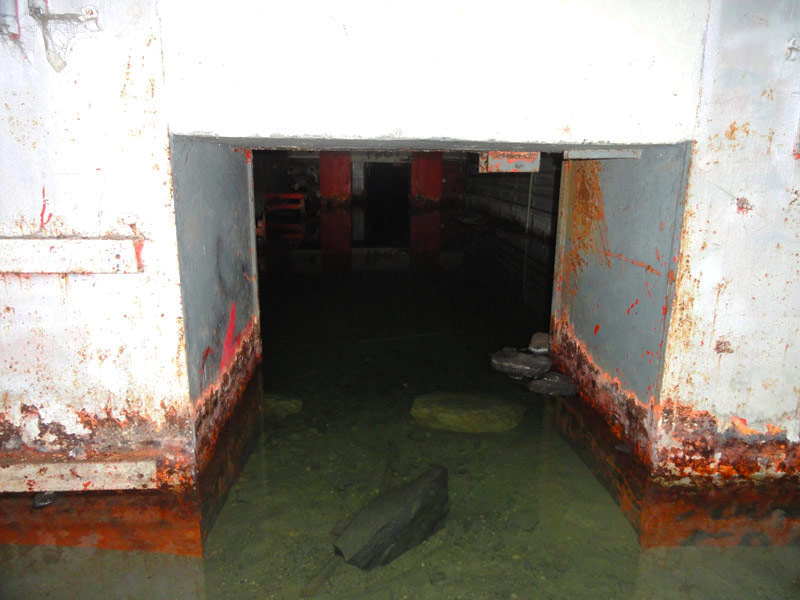
|
|
This
opening into blast lock #2-- normally about 8 feet
high-- has been reduced to about 4 feet by accumulated
sand washed in from the surface.
|
|
Well
let me tell you...
Settling
once again into our damp dinghy, we shoved off over the
deceptively-clear waters of the tunnels. This time however, things
were a bit different.
|
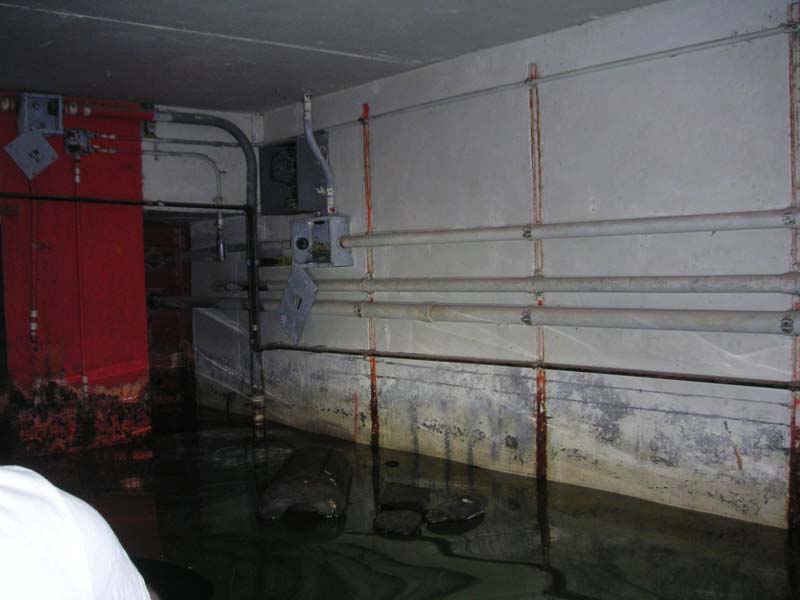
|
|
Inside
blast lock #2, we began to encounter foam glass pipe
insulation. Buoyant and crunchy, it bobbed
innocently around the mouth of the launcher tunnel
ahead.
|
|
Passing
through the blast lock we were greeted with the usual monolithic
concrete painted in bright colors of warning: RED! Caution! Don't
hit your fool head or anything!
|
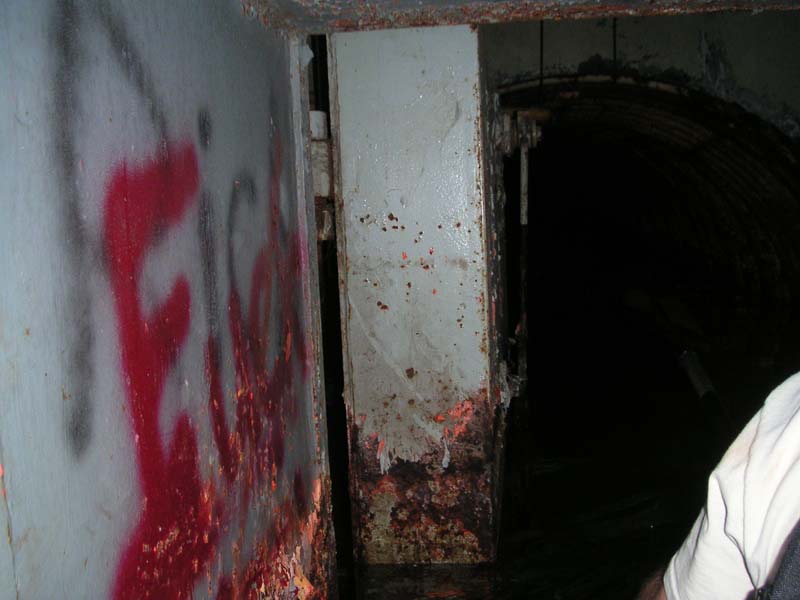
|
|
Inner
blast door of blast lock #2 yielding to the elements and
the launcher tunnels beyond.
|
|
But
once past this familiar bulwark, we were greeted by a sight as-yet
unknown to us. There ahead in the tunnel, something strange
floated on the surface of that calm, clear water.
A
LOT of something strange.
|
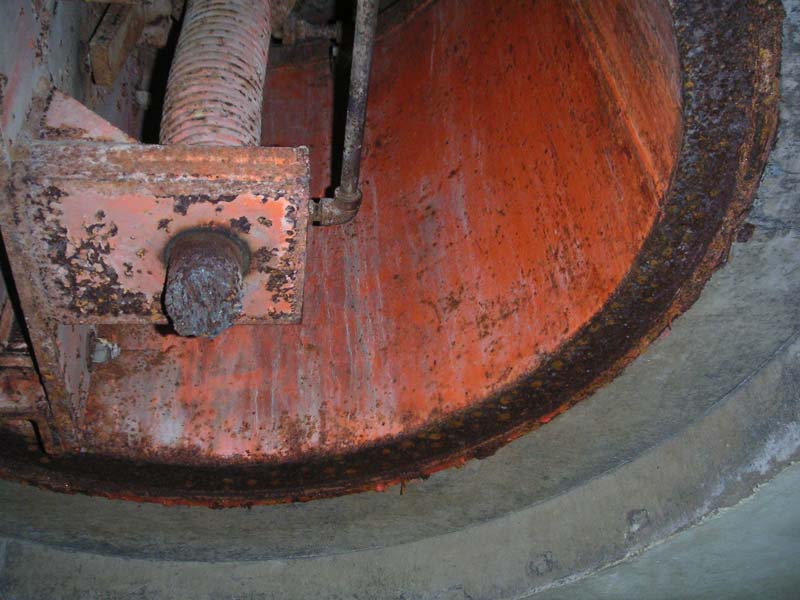
|
|
Looking
up at the ceiling of blast lock #2 at a blast valve that
once protected the blast lock from overpressures
entering via the launcher air system. The valve
plate has been removed, revealing the return spring
above.
|
|
What
Stale Hell is This?
|
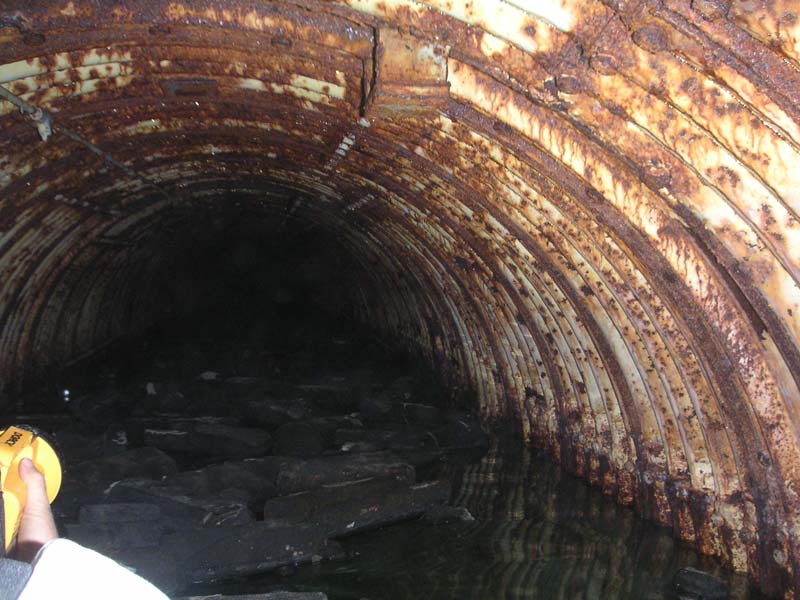
|
|
Launcher
tunnel to silo #1 choked with pipe insulation-- but
there was something else there that lurked
unseen...
|
|
As
we crossed the threshold into the launcher tunnels, we could easily make
out what floated on the surface of the waters ahead. What began as
a few disparate chunks of foam glass pipe insulation quickly turned into
a tunnel filled with discarded, floating, pumice-like material that
covered the surface of the water.
|
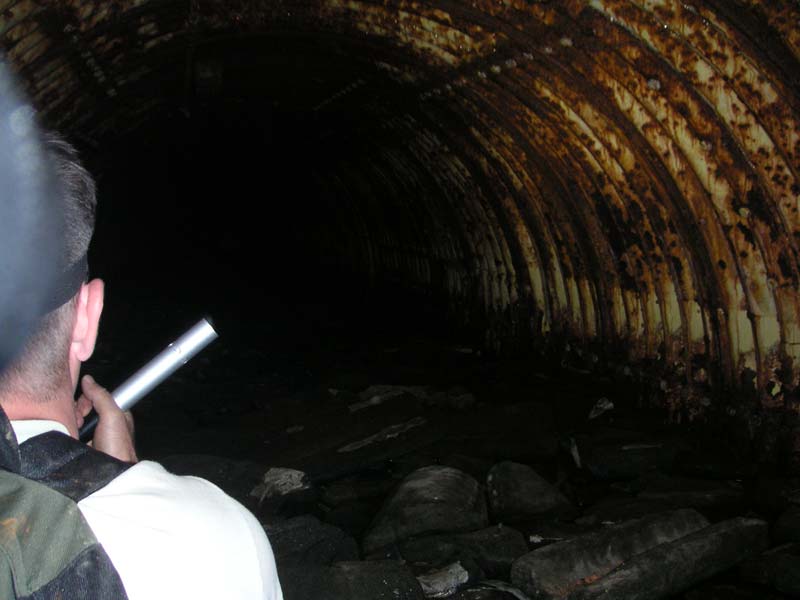
|
|
Moving
forward, the obstruction of the tunnel by disused pipe
insulation worsens making passage increasingly
difficult.
|
|
At
first this was just a bit of a curiosity, some new scenery that bumped
harmlessly against the hull as we moved down the tunnel. Then
there was more and more and more of it until it began to seriously hamper
our progress.
Pushing
our way into the floating mass of debris, Walter was finding that this
unexpected obstacle was making for rough going in the kayak. I
wasn't much help either, my hands full of camera gear and lights, Walter
was stuck doing all the work negotiating this strange gauntlet of
garbage while I sat there like so much ballast.
It
was shortly after we entered this mess that we started to notice a foul
air about the place-- something was rotten here, but we slogged onward
into the engulfing mass that continued off into the darkness without
apparent end.
|
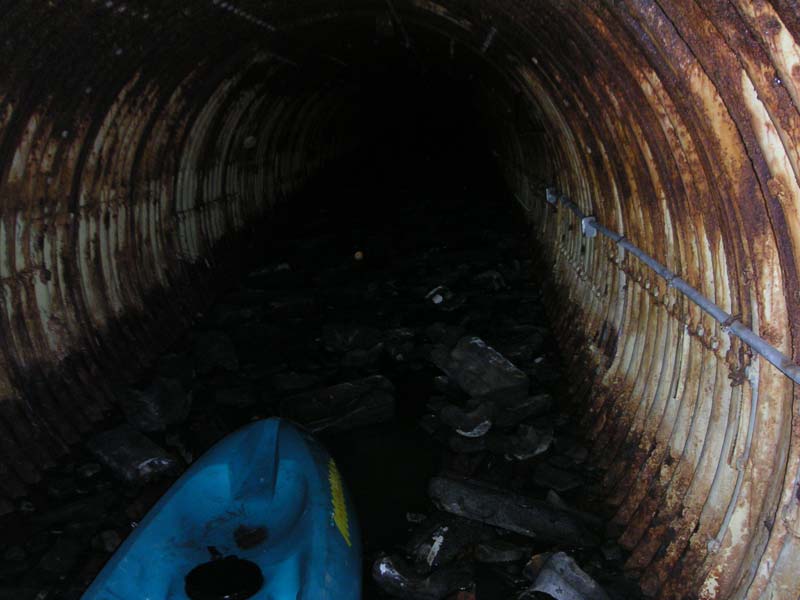
|
|
At
this point the clogged passage had become almost
impassable as the kayak could scarcely pass through it
or over it.
|
|
The
stench grew worse as we became increasingly bogged down in the dense
glass foam, its aroma taking on subtle hints of flatus, delicate notes
of untreated sewage with sulfurous undertones and finishing with a
delicate character of rotten eggs. Uh oh...
We
had both been bitching about the foul odor, but now it occurred to me
that what in fact we were likely to be experiencing was the
"silent-but-deadly" calling card of H2S, otherwise
known as Hydrogen
Sulfide gas.
H2S
and You
All
joking aside, this was no laughing matter for us. Hydrogen sulfide
gas is a killer that strikes down many people every year from oil field
workers to sanitary sewer engineers and maintenance people as well as
unwary urban explorers. It lurks at drilling sites as a petroleum
by-product, unseen coal mine effluent, product of decaying organic
matter in sewers, swamps, unventilated caves, tunnels and other places
with "dead air" and matter left to decompose through the
action of anaerobic bacteria.
Hydrogen
Sulfide is colorless so you'll never see it; it has a
sense-deadening neurological effect making detection by smell difficult
at high concentrations; it is heavier than air and highly explosive; it
is "broadly toxic" in that it attacks the body in several ways
at once, chiefly by attacking the nervous system.
High
concentrations can kill in one breath, and lower concentrations cause
eye damage and injury to other organs. Rapid death is brought on
by the disruption of cellular respiration whereby the body asphyxiates
at the cellular level. This is the same mechanism by which cyanide
kills!!
|
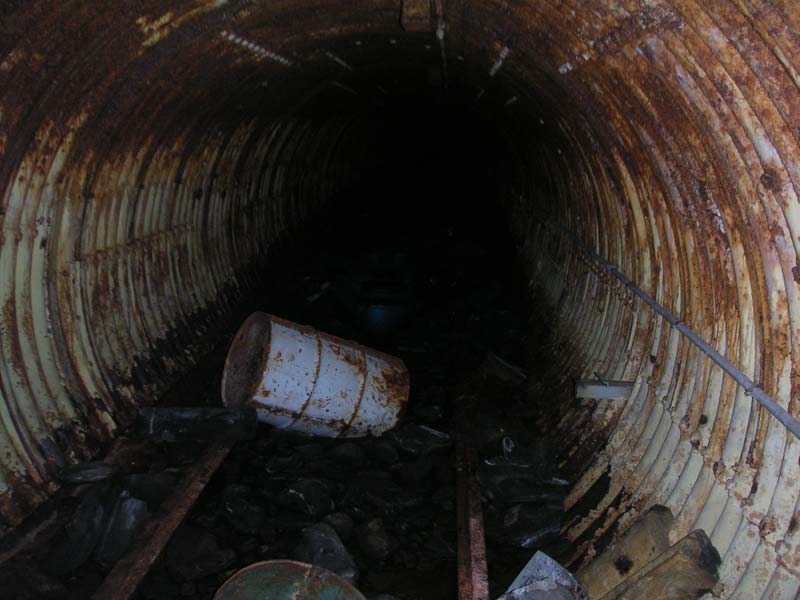
|
|
Here,
all forward movement by watercraft became impossible and
we were forced by necessity to abandon the kayak and
quickly, but carefully pick our way over the mess and
out of danger.
|
|
I
started to develop a bit of a headache and both of us were coughing a
little as we essentially became mired in the floating junk
blocking the tunnel. Working hard to move us forward, I'm sure
Walter was taking on even more of the questionable atmosphere as he
struggled to keep us moving forward..
"This
is probably hydrogen sulfide gas." I rattled nervously. I'd
read about it before in accounts of urban exploration of sewers and
other underground areas. I knew it was extremely dangerous.
"We
better get the hell out of here!" Walter agreed, he was also
getting a headache and feeling dizzy as well. As he mentioned
this, I also noticed I felt a bit dizzy.
Looking
ahead, the end of the tunnel was not yet visible while the bog of foam
glass continued out of sight both in front and behind. I tried to
recall how long this section of tunnel should be-- were we halfway
through? A third? I wasn't sure. Was the air even any
better ahead, or were we driving headlong into our doom?
I
wanted to help push us through the danger, but without an oar, I could
only push against the insulation ineffectually. I stowed my camera
and prepared to abandon ship and run-- but which way to go?
By
this time, Walter was pushing off from the walls of the tunnel with his
oar to better move us along as we held our breath and held out for a
sign of an end to the tunnel of doom in which we had found
ourselves.
With
a few more good shoves, we had moved ahead enough to see that the water
was becoming more shallow and the end of the tunnel was not too far
ahead.
The
entire floor of the tunnel was almost all junk now and several steel oil
drums joined the blockade of detritus in our path. Luckily, the
water was nearly absent at this point and Walter and I agreed it was
high time to abandon ship and set out on foot.
|
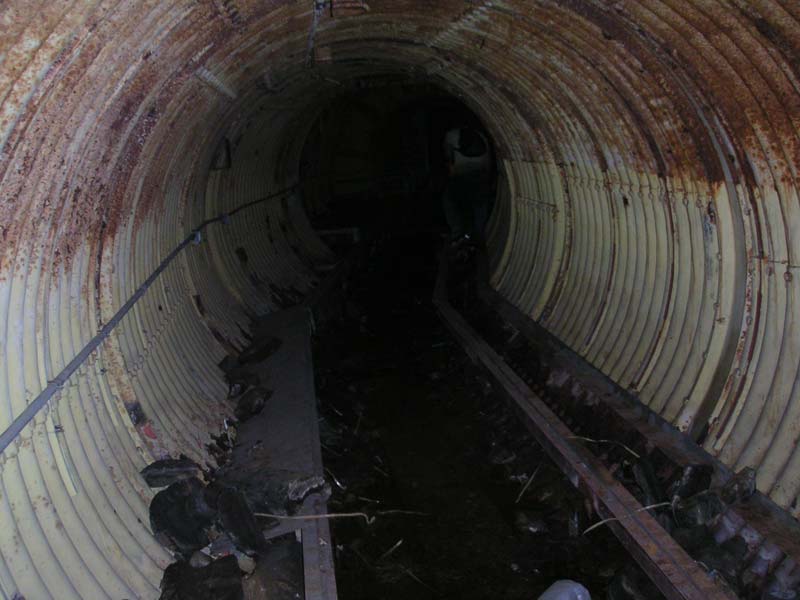
|
|
As
we neared the first tunnel junction, the incline of the
tunnel increased and the water receded along with the
questionable air quality and piles of pipe insulation.
|
|
Fleeing
the stench and the threat of imminent doom, we headed along the narrow
supports to the tunnel junction ahead, dragging the kayak behind us as
we continued ahead on foot. Luckily the air improved as we trudged
ahead onto solid footing; neither of us had really expected the air to
become so treacherous!
|
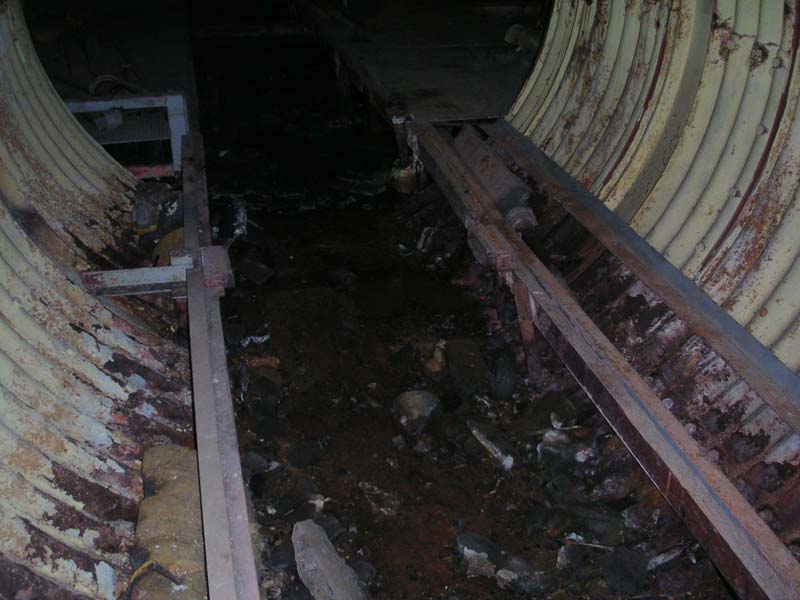
|
|
The
first tunnel junction near the propellant
terminal. Here the tunnels were less flooded
allowing us to move ahead easily and leave the tunnel of
doom behind.
|
|
At
the first tunnel junction the air improved markedly and we both felt
relieved that it appeared that the danger had passed. I had not
expected such a threat from a site that was somewhat ventilated by open
shafts, but stagnant areas can always exist off the main path and
anyone venturing below ground should always take care in places like
these. You never know without monitoring what the air quality
might be. Walter and I were lucky, we could just as easily been
discovered hours later as two corpses in a tunnel.
|
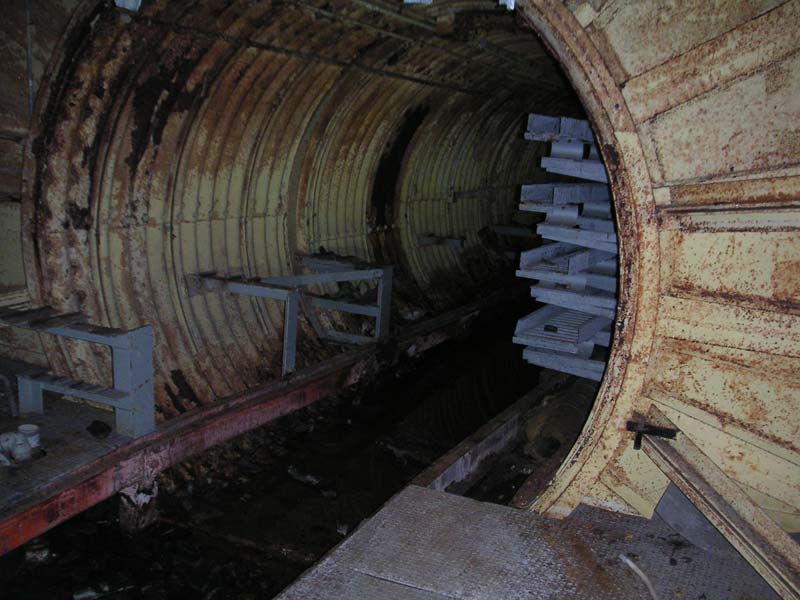
|
|
Tunnel
leading to propellant terminal #1
|
|
As
the water became insufficient to accommodate the draft of our vessel, we
left it behind and quickly moved on. Eager to put some distance
between us and the possible poison gas, we headed directly to the
propellant terminal which was first thing we came to along the
tunnel.
The
propellant terminal would prove to be a bit disappointing however...
|
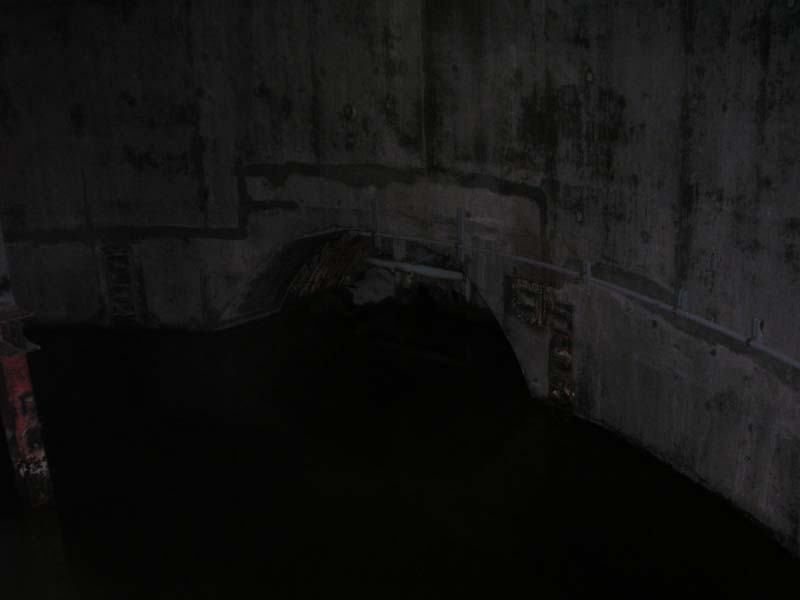
|
|
Propellant
terminal #1 was flooded to a depth of about 8
feet. This meant that the silo was flooded with
roughly 100 feet of water. This photo is looking
toward the interconnecting LOX tunnel that leads to the
LOX fill and vent shaft and launcher silo.
|
|
A
more thoroughly stripped-out propellant terminal I've never seen.
The entire structure was nearly devoid of any features. Worse
still, the flooding left almost nothing above the water line and so
anything that might still be there was hidden below the surface.
Given
the state of things in the propellant terminal, we didn't waste much
time there. We took a few minutes to look around and headed back
to our beached watercraft and forded it to the next flooded section of
tunnel.
|
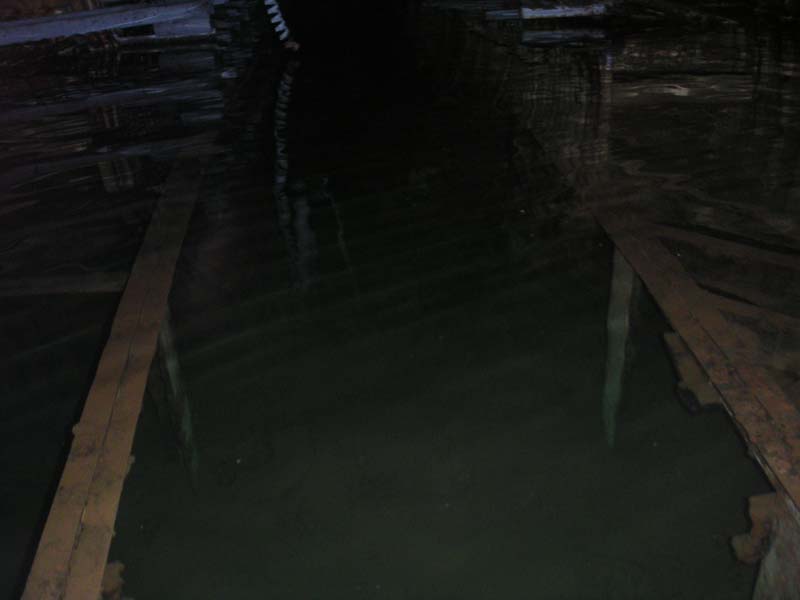
|
|
Steel
supports and framing just beneath the water in the
tunnel junction near the silo and equipment terminal at
launcher #1. The tunnel back to propellant
terminal #1 is up ahead a ways.
|
|
This
would bring us just outside the missile silo and equipment terminal,
where, luckily the water wasn't too deep to allow us to enter either
area. Saving the missile silo for last, we approached the
equipment terminal.
|
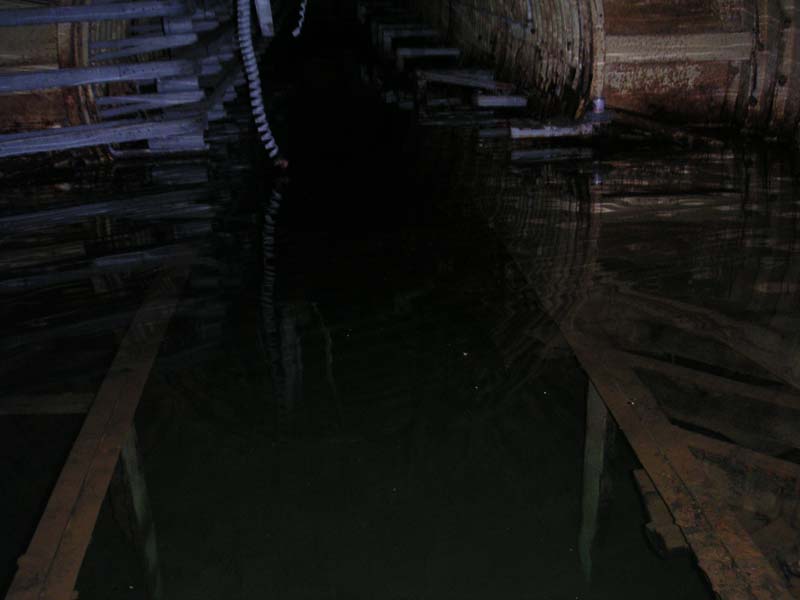
|
|
Looking
down the tunnel back toward propellant terminal #1.
|
|
On
approach to the terminal we could see that it too was flooded of course
and the bottom 3 levels were completely lost to the water.
Additionally, we could see that level IV was basically stripped to the
bare walls and so we opted to skip it as the hour was growing late and
we'd had a long day indeed.
Neither
of us had the foresight to bring any means of keeping time and so we
could only estimate relative to our last reference on the surface what
time it might be. Was it 2pm? 3pm? 4? We had no idea
really.
|
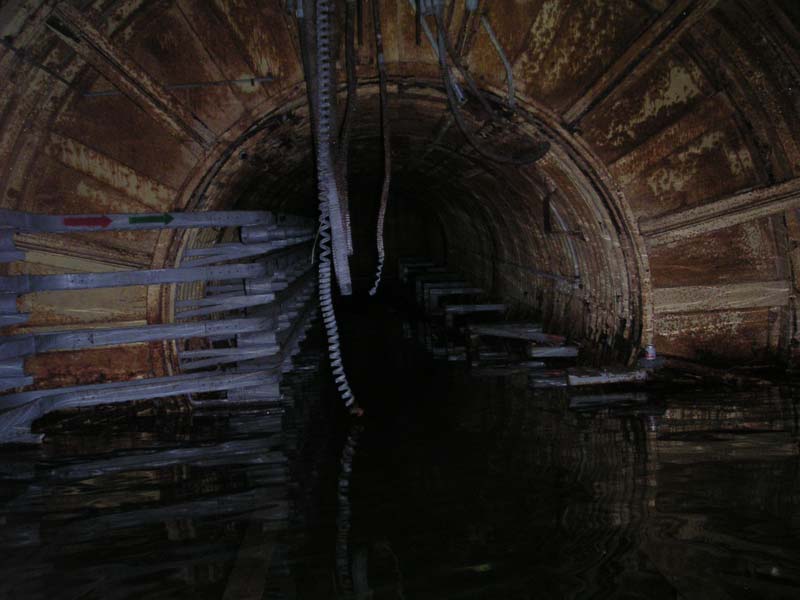
|
|
Another
view down the tunnels toward propellant terminal #1.
|
|
I
snapped a few shots of the entrance to the equipment terminal and we
headed for the main attraction: missile silo #1.
|
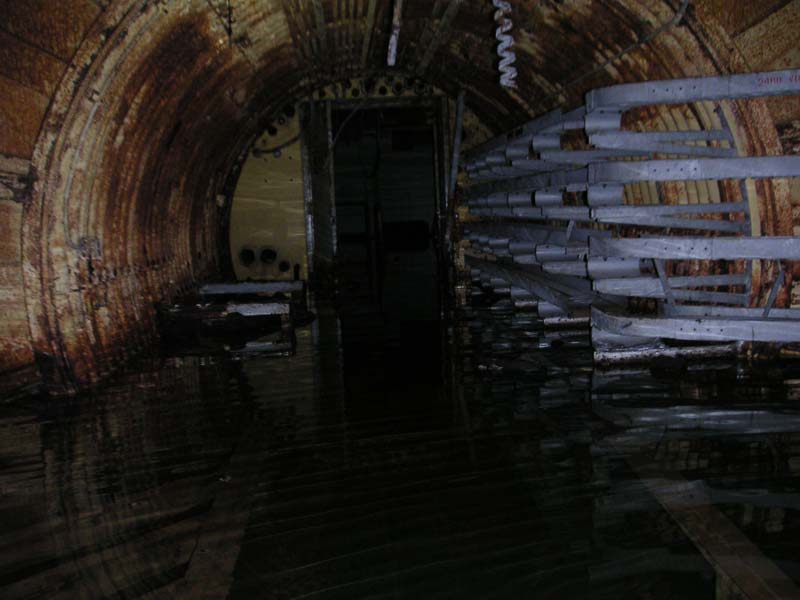
|
|
The
tunnel junction near the silo and equipment terminal at
launcher #1. Equipment terminal #1 is straight
ahead.
|
|
|
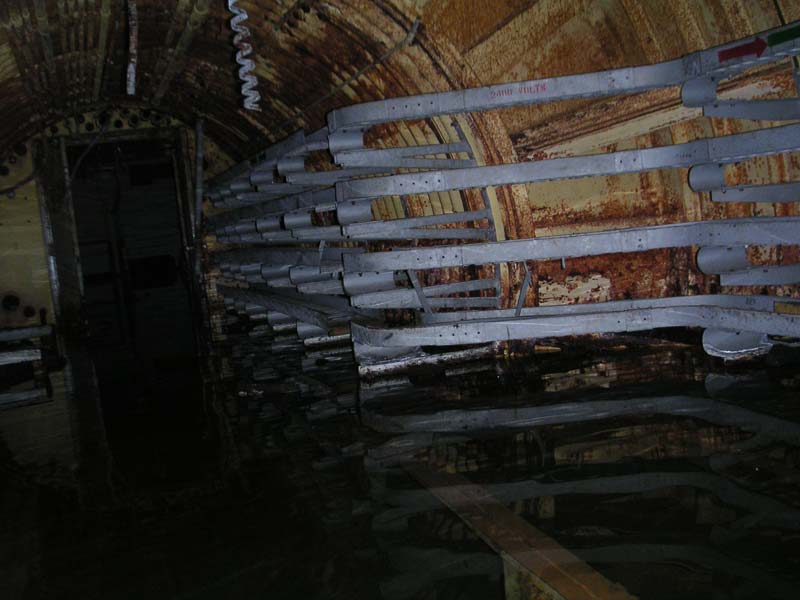
|
|
One
last look toward the entrance to equipment terminal #1
before we plot a course for silo #1.
|
|
|
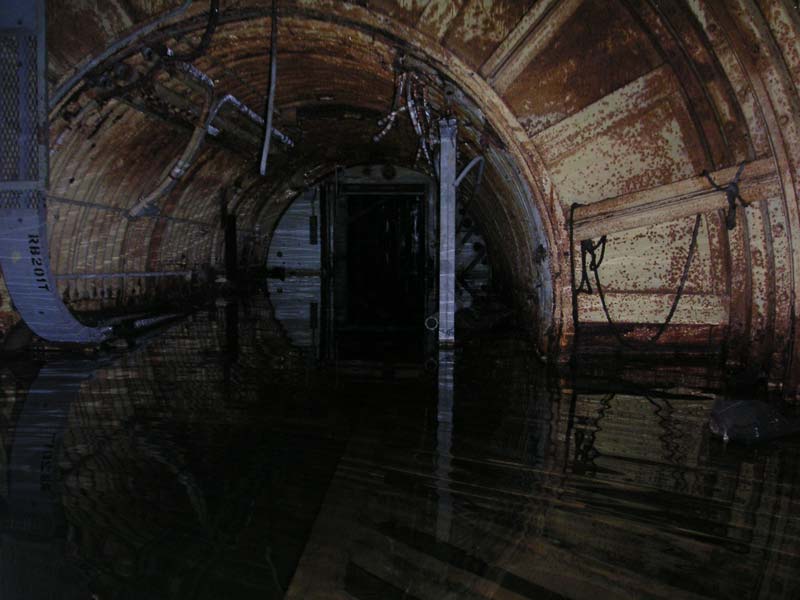
|
|
Silo
#1 dead ahead. Even flooded as it was, the rust
was not as bad as one might expect. Perhaps
airflow through the tunnels has helped keep the
oxidative forces of nature slightly at bay.
|
|
It
looked like clear sailing once again as the entrance to the silo was
flooded to where we could just drift right through the door. As
usual, most of the interesting stuff had been removed from the
connecting tunnel, but we did see something new near the doorway.
|
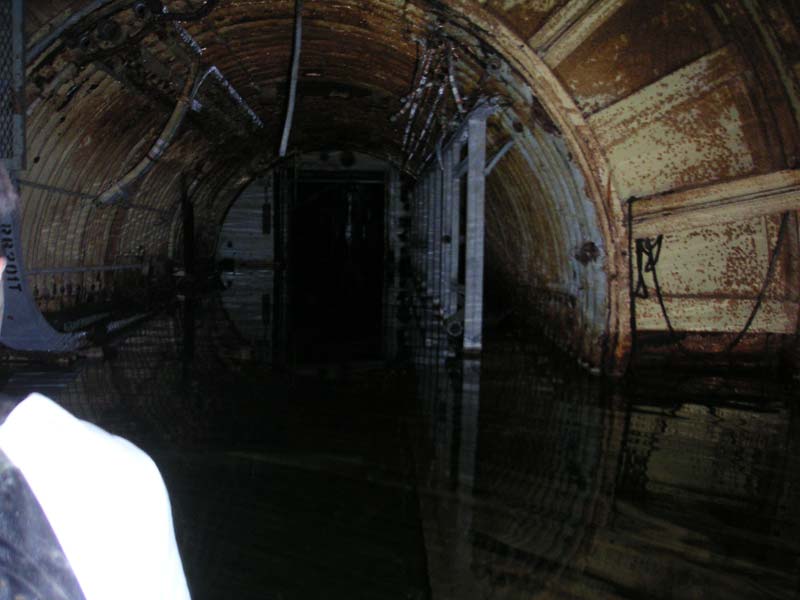
|
|
Starting
our approach to silo #1
|
|
To
the left of the doorway there was a tall, narrow control box of some
sort. Neat!
|
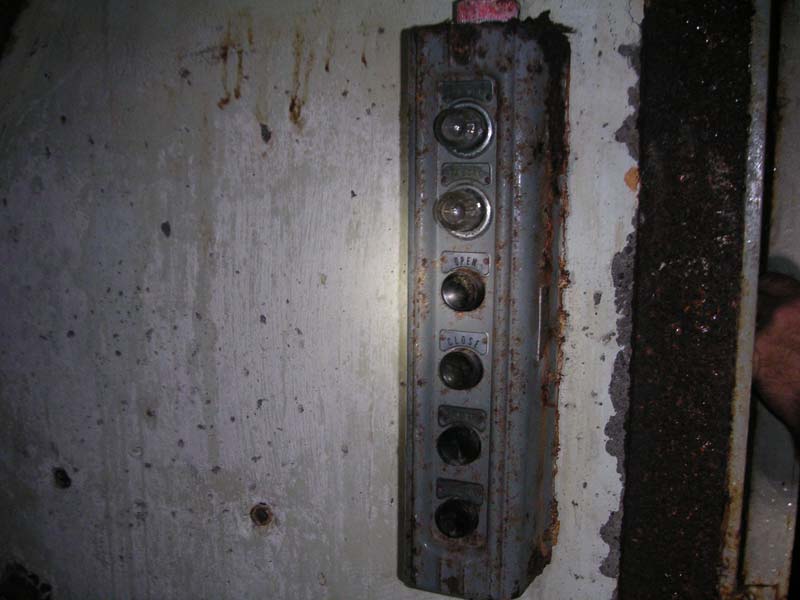
|
|
A
indicator and control box outside the silo doors with 2
lights and 4 buttons. It appeared nearly ready to
drop off the wall and into the water.
|
|
We
moved in to take a closer look and found the box had 2 lights and 4
buttons on it. The lights were labeled: FAIL WET, and FAIL
DRY. Below them the buttons read: OPEN, CLOSE, FAIL WET, FAIL
DRY. Hmmm...
Best
guess was that this was a local control panel for the fire water system
in the silo that controlled the fog nozzles and deluge system.
|
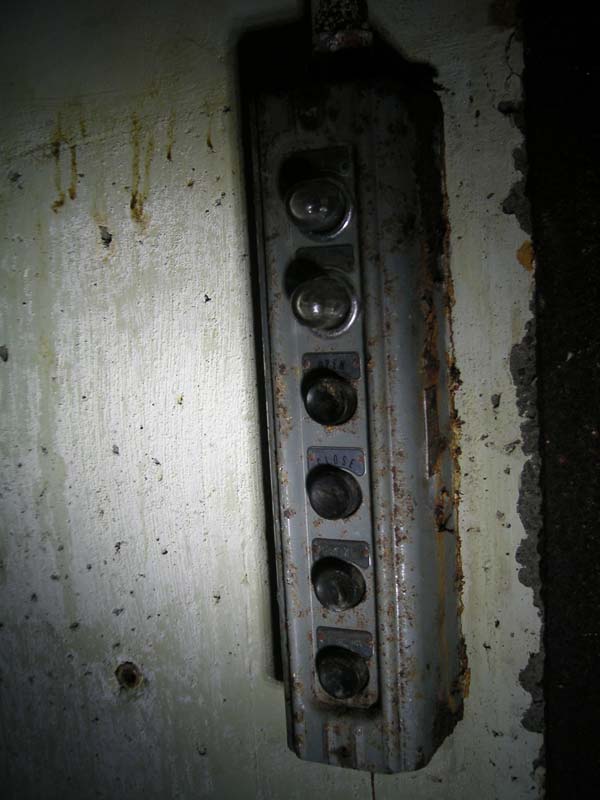
|
|
A
closer look at the control box outside silo #1
|
|
It
was neat to see one of these, never saw one turn up at any other
site. Needless to say we pressed every button, but no luck, they
just wouldn't do anything. We pressed the "OPEN" button
and headed into silo #1.
Tune
in soon for the next installment:

